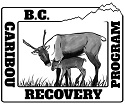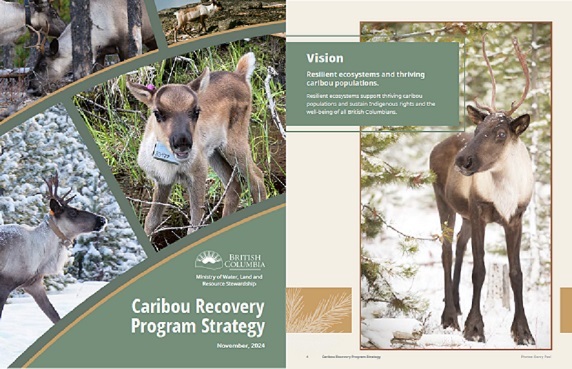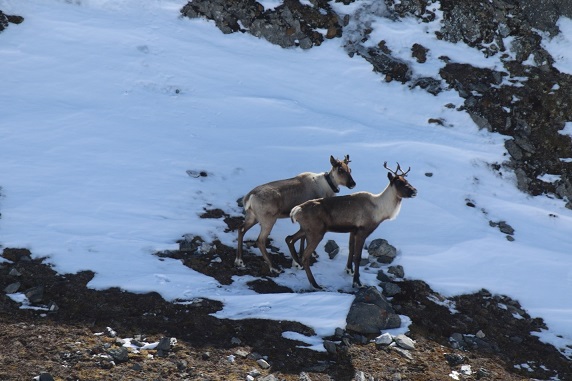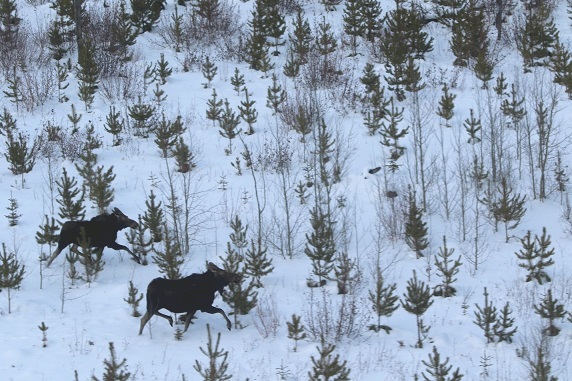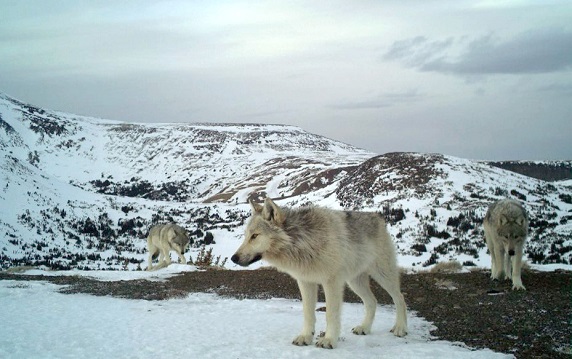Resources
Caribou Recovery Program
Edition: Caribou Recovery Program Newsletter - Winter 2024
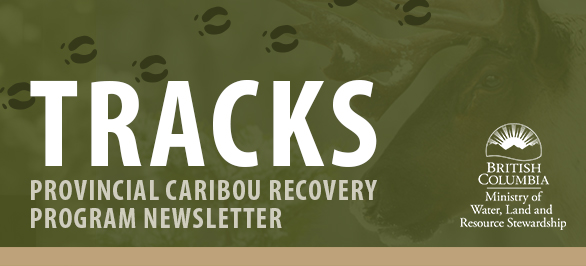
Volume 2, Winter 2024 |

Caribou Recovery Program StrategyThe Caribou Recovery Program Strategy is comprised of our program’s vision, goals, objectives, and strategies. This document represents the culmination of our successes, challenges faced, and lessons learned over the first five years of the program. The strategy’s vision focuses on resilient ecosystems that support thriving caribou populations and is our guiding principle. Vision: “Resilient ecosystems support thriving caribou populations and sustain Indigenous rights and the well-being of all British Columbians.” The Four Goals that Drive Program Actions:
Goal 1: Caribou Recovery
Goal 2: Inclusive Stewardship
Goal 3: Durable Provincial Program
Goal 4: Well-Informed Decisions
Through the Caribou Recovery Program’s collaboration and partnerships with First Nations and other interested parties, we continue to pursue the goal of seeing caribou populations in B.C. return to self-sustaining levels. Read more about the Caribou Recovery Program Strategy. |


Caribou Recovery Planning and Implementation
Over the summer of 2024, the program’s Planning Initiatives Team continued to engage with First Nations about caribou recovery and also started conversations with new partners. We have also focused our efforts on work planning to ensure we have successful and efficient planning processes in place that will lead to lasting solutions. The Planning Initiatives team, now with more support than ever before, is excited to continue building relationships throughout the province and foster a shared responsibility for caribou recovery.
The Southern Group's Southern Mountain Caribou Habitat Initiative is ongoing in 3 herd ranges (Groundhog, Columbia North, Central Selkirks), and we’re excited to start the formal planning process this winter for the following additional herds:
- Wells Gray South
- Wells Gray North
- Barkerville
- North Cariboo
- Parsnip/Hart South
Recovery planning for the Northern Group of southern mountain caribou continues through multiple forums, including the Chilcotin Caribou Technical Working Group, Environmental Stewardship Initiatives, and focused conversations with First Nations.
The Boreal Caribou Recovery Technical team is focused on caribou habitat restoration in boreal areas. The team is developing priority restoration guidelines and identifying key areas of caribou habitat. These guidelines will help ensure consistency in habitat restoration practices, and support coordinated planning and restoration efforts throughout the boreal caribou range.
The 2020 caribou Partnership Agreement:
- We are currently revising the Partnership Agreement Caribou Recovery Committee’s “Guidance to Proponents on Applications” document. Stay tuned for this new and improved guidance in the coming months.
- The Partners have been meeting regularly with forest licensees that are operating in the Partnership Agreement area. We share information with them about different forestry practices and how they might influence caribou recovery.
- Early this winter, the Partners are planning to review how enhancements are made to areas where snowmobiling is currently allowed.
The Partnership Agreement Caribou Recovery Committee’s reporting for 2022 and 2023 is currently under review and will be released in the near future on our website: Caribou Recovery Program - Province of British Columbia


Caribou Population Surveys
Caribou Population Surveys for 2024-25
We have a busy winter planned as we prepare to conduct priority caribou population surveys in 2025, as well as catch up on surveys that were planned for last winter but had to be postponed due to poor surveying conditions at the time.
To estimate the size of a mountain caribou herd, we survey most or all of their high-elevation winter ranges (and low-elevation ranges if needed) to count all the caribou. We also determine “recruitment” levels (i.e., how many calves are 10 months old and have survived their first winter), based on the number of calves observed versus the number of adults observed.
Favourable weather and flying conditions for late-winter surveys include suitable snow conditions (with adequate snow coverage and depth that allow us to see the animals and/or their tracks) and more hours of daylight. Together, these factors contribute to good visibility of the animals.
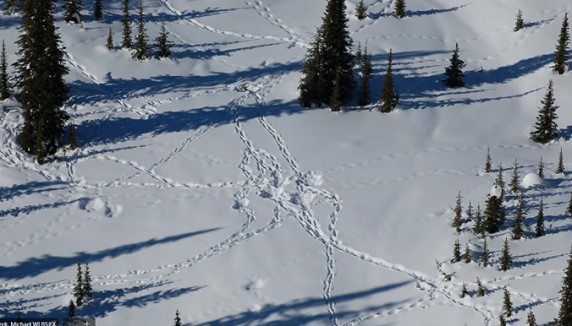
Fresh caribou tracks observed in subalpine meadow during the late winter Central Selkirks survey
As snow accumulates in the lower elevation forest, caribou move up to higher elevations where they forage on terrestrial lichens on windswept alpine ridges or on arboreal lichens within subalpine forests. When caribou are at higher elevations, they are typically easier to observe from the air.
We know that some caribou are missed during surveys due to their reduced “sightability” (visibility) if they move down into thicker canopy forests or simply because they blend really well into their surrounding habitat – even when they’re out in the open. The photos below illustrate how well caribou blend into their environment in both open higher-elevation plateaus and in forested habitats.
To obtain more reliable population estimates, we deploy a set number of GPS/radio collars on caribou herds throughout the survey area and use “mark-resight” techniques when we survey those herds.
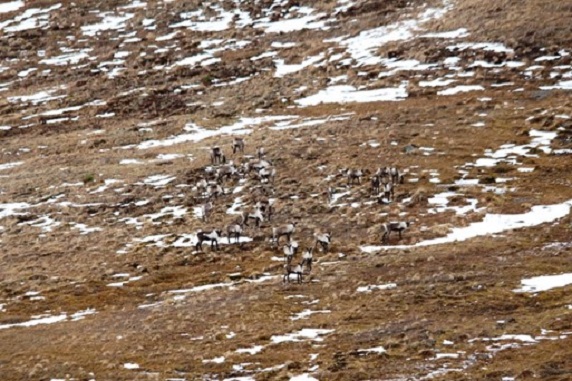
Group of 26 caribou on windswept plateau
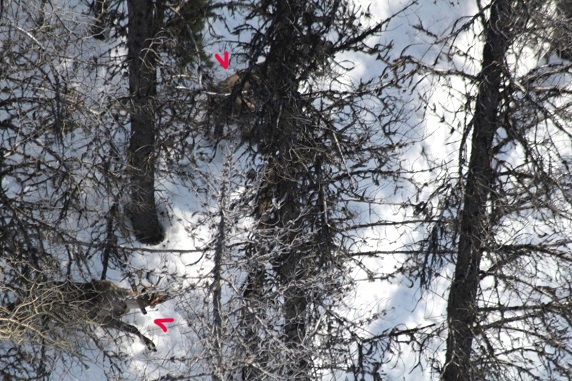
Aerial view of two caribou in forest habitat
| Total count: Counts all caribou in a defined survey area, which typically includes an aerial survey of all known caribou ranges for a given season (i.e., late winter, post-calving, rut season). The total count can be used as a population estimate and may be adjusted for visibility or “sightability”. Mark-resight: Follows a total count survey methodology and uses GPS/radio collars to increase confidence in the quality of survey results. During aerial survey of a caribou range, surveyors note how many observed caribou have GPS/radio-collars versus the total number of known collared caribou within the survey area. The proportion of collared animals sighted (e.g., 9 out of 10) provides an estimate of “sightability”, which is used to calculate a population estimate. Confidence interval (CI): The confidence interval is a range of values within which the true population size is estimated to fall, along with a level of confidence in that estimate. For example, a population estimate of 185 animals may have a confidence interval of 150-205, which is the range that would have a 95% chance of capturing the true population size. |
Our first caribou surveys of the 2024-25 season occurred in June 2024 in the Chilcotin ranges. A mark-resight survey was flown over the Itcha-Ilgachuz caribou range and total count surveys were conducted for the adjacent Charlotte Alplands and Rainbow Mountains caribou ranges. In mid-October 2024, a rut survey was undertaken for the Telkwa range to estimate the population size there, as well as the number of bulls, cows and calves in the Telkwa caribou herd. Results from both surveys are pending.
| Rut survey: Caribou are counted within their rutting range (typically on alpine ridges, plateaus, or lower- elevation meadows) to estimate the herd’s composition, which indicates the ratios of bulls to cows and calves in the herd. This type of survey is typically conducted in the fall or early winter when caribou congregate during the rut season and bulls have antlers. |
Late this winter (March 2025), we are planning to conduct surveys in the following 11 caribou ranges, provided conditions are suitable:
- Muskwa
- Pink Mountain
- Wolverine
- Takla
- Quintette
- North Cariboo
- Barkerville
- Wells Gray North
- Wells Gray South
- Columbia North
- Central Selkirks
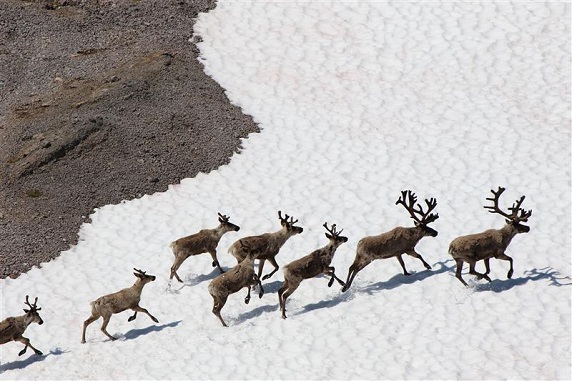
Caribou observed on the snowpack during the June 2024 survey in the Itcha-Ilgachuz range
2023-24 Caribou Survey Results
The winter of 2023-24 was challenging for conducting caribou surveys in some areas of the province due to a lower-than-average snowpack. A low snowpack can cause caribou to spend more time in lower-elevation forests during late winter, which reduces the visibility of caribou during aerial surveys. Several surveys were postponed in the south and northeast portions of the province for this reason.
With support from their partners, biologists with the Caribou Recovery Program were still able to complete surveys in many key areas to obtain updated population estimates. Results from these surveys are summarized below. This information helps us determine the population size and status of a herd (i.e., its current trend) and understand responses to ongoing caribou recovery actions within those herds. An increased population estimate and/or recruitment level, indicating 15% or more of the herd consists of calves, are both indicators of population growth within that herd.
Current trend: Refers to population trend over the last 5-9 years (1 caribou generation is estimated at 9 years) depending on data availability and timelines of management actions. Recruitment estimates: Recruitment surveys occur in late winter and aim to estimate the caribou herd’s population and the percentage of calves that will become juveniles (i.e., how many calves survived their first winter) also known as “calf recruitment”. The percentage of calves provides a good indication of whether the population is growing, stable, or decreasing. (When calves make up at least 15% of a caribou population, that is considered the minimum target for herd growth). |
In 2023-24, surveys were conducted in all 5 Boreal Caribou herds, 1 herd in Northern Mountain Caribou, 4 herds in Southern Mountain Caribou - central group, 4 herds in Southern Mountain Caribou - northern group, and 4 herds in Southern Mountain Caribou - southern group. See map for caribou herds surveyed.
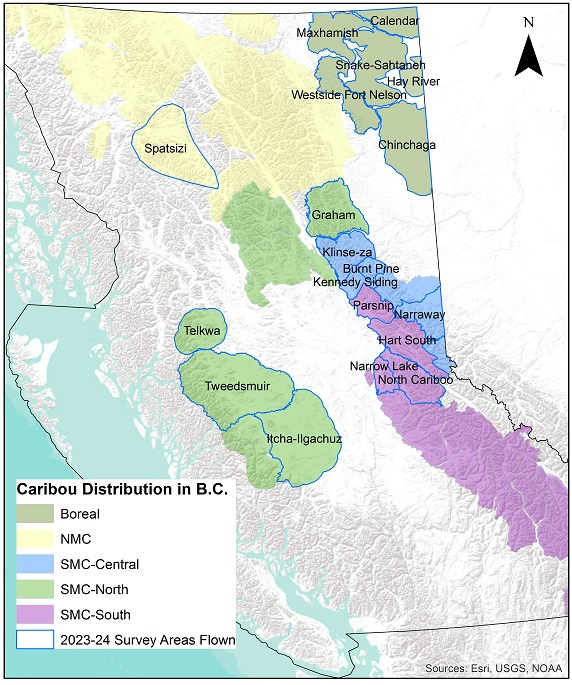
The survey results for each herd are explained in more detail below.
Itcha-Ilgachuz
Survey type: mark-resight
Population estimate: 551 caribou
Current trend: stable
Recovery actions: wolf reduction
Herd details:
- The survey provided similar counts to 2020 (500 caribou) and 2021 (550 caribou).
- Wolf reduction was implemented in 2020 to support caribou recovery.
Tweedsmuir-Entiako
Survey type: mark-resight; calf recruitment
Population and recruitment estimates: 263 caribou (95% CI: 248 – 344); 23% calves
Current trend: increasing
Recovery actions: wolf reduction
Herd details:
- During the rut survey in October 2023, most caribou were at high elevations and sightability was good (88%).
- During the March 2024 recruitment survey, approximately 70% of the caribou had moved down to low-elevation forested habitats.
- 162 caribou were observed, 23% of which were calves.
- The Tweedsmuir-Entiako herd increased since a survey in 2021 (198 caribou).
- Wolf reduction was implemented in 2020 to support caribou recovery.
Telkwa
Survey type: calf recruitment
Recruitment estimate: 18% calves
Current trend: stable, increasing
Herd details:
- This herd experienced a slow increase, but the population remains small and continues to be at risk of extirpation.
- 34 caribou were observed during the survey.
Graham
Survey type: mark-resight
Population estimate: 417 caribou (95% CI: 254 – 706)
Current trend: increasing
Recovery actions: wolf reduction
Herd details:
- 272 caribou were observed with 57% sightability (12/21 collars).
- This herd’s population increased since 2021, when there were an estimated 197 caribou.
- Wolf reduction was implemented in 2020 to support caribou recovery.
Klinse-za
Survey type: mark-resight
Population estimate: 159 caribou
Current trend: increasing
Recovery actions: wolf reduction and maternal pen
Herd details:
- This herd was formerly referred to as the Moberly and Scott East herds.
- A minimum of 158 caribou were observed in the range. Forty caribou were below the treeline, making a sightability estimate challenging.
- This herd has tripled in size since 2013, when recovery actions were implemented. The 2024 estimate is an increase compared to the 2023 population estimate of 132 caribou and represents an annual growth rate of 20.5%.
- The survey was conducted by the Nîkanêse Wah tzee Stewardship Society. Read more here.
Kennedy Siding (and Burnt Pine Range)
Survey type: mark-resight and photo-census
Population estimate: 155 caribou with mark-resight; 154 caribou with photo-census
Current trend: increasing
Recovery actions: wolf reduction and supplemental feeding
Herd details:
- In March 2023, the survey conditions were excellent with 100% sightability of collared caribou. Over 100 caribou were observed in the Burnt Pine range, including 13 of the 15 GPS-collared caribou.
- Photos from trail cameras at the supplemental feeding stations were analyzed to identify individual caribou, based primarily on antler structure.
- The population of the Kennedy Siding herd has tripled since recovery actions (wolf reduction/supplemental feeding) were implemented in 2014.
| Camera monitoring (photo census): Wildlife cameras are placed in locations where there is a unique opportunity to closely monitor caribou demographics (i.e., the ratios of bulls, cows and calves, survival rates and individual caribou condition). This technique is only being used at the Kennedy Siding supplemental feeding site. This is because, in most years, the entire herd moves to low-elevation winter range near the feeders. |
Narraway
Survey type: recruitment
Recruitment estimate: 23% calves
Current trend: stable, increasing
Recovery actions: wolf reduction
Herd details:
- 105 caribou were observed during a survey flight conducted by Alberta government staff.
Hart Ranges - Parsnip
Survey type: mark-resight
Population estimate: 224 (95% CI: 207-272)
Current trend: increasing
Recovery actions: wolf reduction
Herd details:
- There was good sightability during the 2024 survey (82%).
- The population of this herd has significantly increased since the 2022 survey (147 caribou).
- Wolf reduction was implemented in 2020 to support caribou recovery.
Hart Ranges - Hart South
Survey type: mark-resight
Population estimate: 512 (95% CI: 339-685)
Current trend: increasing
Recovery actions: wolf reduction
Herd details:
- The previous estimate (in 2022) suggested there were 359 caribou in the Hart South herd.
- Caution has been used when interpreting population trends based on the 2024 survey. There was poor sightability in 2024 (58%) and staff counted fewer caribou in the Hart South range in 2024 (342 caribou) compared to the 2022 survey (359 caribou). Larger correction factors associated with poor sightability can result in an overestimated population.
- Wolf reduction was implemented in 2020 to support caribou recovery.
North Cariboo
Survey type: recruitment
Recruitment estimate: 11% calves
Current trend: stable
Recovery actions: wolf reduction
Herd details:
- Survey conditions were poor in 2024. Most caribou had congregated in forests with thicker canopies, where it was difficult to see and to classify the age of the animals.
Narrow Lake
Survey type: total count
Population estimate: 3
Current trend: decreasing
Herd details:
- Only one caribou was observed in the Narrow Lake range during the previous survey (in 2023), which indicated a continued population decline in this herd since 2016 (when 36 caribou were observed).
- This herd continues to be at high risk of extirpation.
Spatsizi
Survey type: mark-resight
Population estimate: 1536 (90% CI: 1165 – 1904)
Current trend: unknown
Herd details:
- This range was last surveyed in 1996. The current population trend is unknown.
Boreal Caribou – All Herds
Survey type: calf recruitment
Population and recruitment estimates: 19.5% calves (minimum number of caribou known to be alive was 870).
Current trend: stable
Herd details:
- The caribou ranges surveyed: Snake-Sahtaneh, Maxhamish, Calendar, Westside Fort Nelson, Hay River, and Chinchaga.
- Results from survival and recruitment monitoring suggest that these caribou populations are relatively stable.
- The Caribou Recovery Program is working on obtaining robust population estimates in each range through DNA mark recapture surveys.
DNA mark recapture surveys: Helicopters fly along transects looking for the presence of caribou (tracks or animals) and land to collect fecal pellets for DNA analysis. The DNA is analysed in a laboratory to identify individual caribou. An individual is considered “recaptured” when its genetic profile appears across two or more sampling sessions. The proportion of recaptures is used to generate a population estimate. The genetic information can also help determine population size, genetic diversity and/or mixing between adjacent herds. These surveys have focused on boreal caribou ranges where caribou are more difficult to see from the air. Minimum number known alive: The minimum number of caribou known to be alive in a specified area. |
Two adult caribou cows observed during the Hart Ranges caribou survey in March 2024
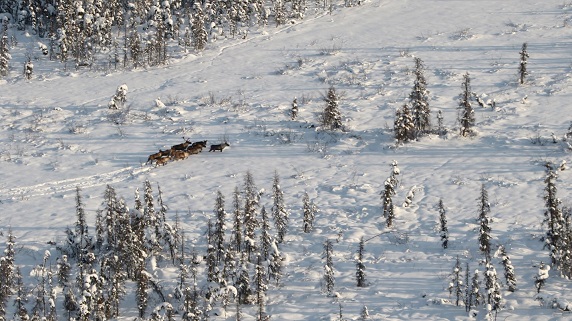
Ten Boreal caribou observed during a population survey in 2024


Predator and Prey
2023-24 Moose Population Survey Results
Two moose population aerial surveys were conducted in the Klinse-za and Tweedsmuir-Entiako ranges in January 2024. This was done to assess changes in moose abundance in response to predator reduction measures undertaken in these areas to support caribou recovery.
For the Tweedsmuir-Entiako range survey area, an estimated 2,415 moose (90% CI: 2032-2799) were present, suggesting that the moose population increased by 54% since 2019, when the moose population was estimated to be 1,572 (90% CI: 1285-1859). The survey was conducted collaboratively with the Cheslatta Carrier Nation.
For the Klinse-za range, the previous aerial survey was conducted in 2017 and estimated that 1,063 moose were present (90% CI: 1022-1104). In 2024, the estimated density of the moose population increased from 0.44 per km2 in 2017 to 0.87 moose per km2 in 2024. The 2024 moose population was estimated to be 2,105 (90% CI: 1882-2328). This survey was planned and delivered collaboratively by the Province of British Columbia and Wildex Consulting.
Although wolf reduction measures are used strictly in the short term to benefit caribou, they also reduce predation pressure on moose and increase moose survival rates. Thus, careful monitoring of the moose population is required to fully understand the predator-prey dynamics of the ecosystem. Moose population increases may lead to rapid recolonization by wolves in these areas and could make wolf removal programs less effective and/or lengthen the duration of predator reduction measures.
Moose observed during a survey of the Tweedsmuir-Entiako range in January 2024
2023-24 Wolf Survey Results
In the late winter of 2024, a “minimum count snow track survey” of wolves was completed in the Chase caribou range to estimate the density of the wolf population, the number of packs, and their distribution. Tracking conditions were good, with over 10 centimeters of snowfall six days prior to the survey, and a light snowfall two days before the survey that allowed for better differentiation of the relative age of wolf tracks.
A total of 35 wolves were observed in six packs, and the survey crew detected another six packs based on tracks that were present in the area. The minimum population density of wolves within the study area was 7.6 wolves/1,000 km2 when including an assumed proportion of 10% lone wolves, or 6.9 wolves/1,000 km2 when not including lone wolves.
Updated information on wolf populations and distribution is required to better inform our understanding of the current condition of caribou herds and inform caribou recovery planning.
This survey was conducted collaboratively by the Province of British Columbia, Tsay Keh Dene Nation, and Chu Cho Environmental LLP.
Three wolves on a windswept ridge in the Itcha Ilgachuz caribou range
Predator Reduction to Support Caribou Recovery in B.C.: 2023–24
One of the objectives of B.C.’s predator reduction program is to reduce the number of wolves in caribou ranges. Lower wolf population densities will help increase caribou survival rates, calf recruitment and, ultimately, caribou population growth. This emergency strategy is necessary in the short term to address unnaturally high predation pressure and support the recovery of caribou populations in the province.
Years of research on predator reduction measures demonstrate that this approach has immediate, positive impacts on caribou populations. It has been shown to be an effective short-term action for recovering threatened caribou herds when applied as part of an adaptive management framework. Predator reduction programs require scientific rigour, high standards for humaneness, and ongoing monitoring and assessment.
Aerial-based wolf reduction has been applied to 15 of the 54 identified woodland caribou populations in British Columbia, including two caribou herds added in 2024: the Barkerville herd and the Takla herd (delivered collaboratively in partnership with Takla Nation).
Targeted ground-based removal of cougars was applied in two caribou ranges: Central Selkirks and Columbia North. and cougar reduction targets were achieved for most herds and are expected to contribute significantly to caribou population stabilization or growth.
Monitoring of caribou populations’ response to predator reduction will continue. It is imperative to recognize that to achieve long-term caribou population sustainability, habitat protection and habitat restoration measures must continue to be prioritized and implemented.
Read more about Predator Reduction to Support Caribou Recovery in 2023-2024.
See recent research assessing this management activity: Effectiveness of population-based recovery actions for threatened southern mountain caribou


Learn More
